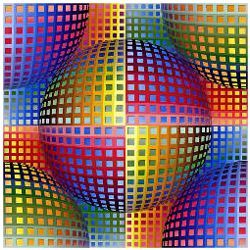"a shape that ... lies halfway between a square and a circle"
This is work by Guy Kindler, Ryan O’Donnell, Anup Rao, and Avi Wigderson, published in Spherical Cubes and Rounding in High Dimensions (2008), and in Spherical Cubes: Optimal Foams from Computational Hardness Amplification (2012).

Foam problems are concerned with how one can partition space into "bubbles" which minimize surface area. We investigate the case where one unit-volume bubble is required to tile $d$-dimensional space in a periodic fashion according to the standard, cubical lattice. While a cube requires surface area $2d$, we construct such a bubble having surface area very close to that of a sphere; i.e., proportional to $\sqrt d$ (the minimum possible even without the periodicity constraint). Our method for constructing this "spherical cube" has a surprising inspiration: foundational questions in the theory of computation—specifically the issue of "hardness amplification". We additionally show an algorithmic application of our new foam: a method for "coordinated discretization" of high-dimensional data points which has near-optimal resistance to noise. Finally, we provide the most efficient known cubical foam in 3 dimensions.
Just to supplement Carlo's answer with a figure that illustrates this intermediate cube-sphere shape in $\mathbb{R}^3$, from the 2012 paper he cites—"we provide the most efficient known cubical foam in 3 dimensions":
